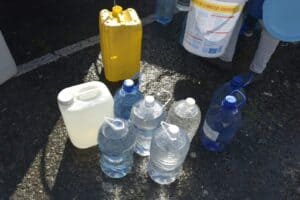Method is practical, but needs more development.

Grey skies, a cool wind and low hanging dark clouds – this was what people in Cape Town woke up to yesterday.
It was a far cry from days of blistering heat, hot dry winds and blue skies as the far the eye can see.
Locals are not hopeful, however, with some saying they had seen it before, only for a southeaster to blow it all away.
Rain predictions in some quarters guessed up to an 80% chance of rain last night, up from a 10% chance during the day.
However, the effect may be fleeting with no rain and a blustery gusty day predicted for tomorrow.
Major dam levels in the Western Cape yesterday saw the Berg River dam at 53.4%, the Theewaterskloof at 12.3% and the Voëlvlei dam at 17%.
With no apparent end to the ongoing drought, fishing group Oceana is installing desalination plants at two of its processing plants on the west coast.
Oceana’s Dayne Stern said in a statement the installation of a R2 million reverse osmosis plant to decrease boiler feed water consumption would be completed during the next few months.
However, both plants will still be in danger of having to close down unless they can become self-sufficient in their water supply.
With more than 2 000 people employed by the company, a R200 million annual wage bill, a forced closure could have huge effects on the local economy.
“At the St Helena Bay factory, which is the largest of the two plants, Oceana is investing R20 million for phase one of a desalination plant installation that will produce 800 000 litres of water per day.
This will ensure that the factory remains operational and does not draw on the municipal water supply,” said Steyn.
“The installation is estimated to be complete at the end of March and will include two 1 000 000 litre storage tanks. Beach wells are being installed for sea water supply and the discharge pipe will extend 1.3km into the sea to help with the safe dispersion of brine effluent.”
There are other instances of business and government working together.
One which had foresight in 2011 was the Mossel Bay municipality, which commissioned a desalination plant from Veolia Water Technologies – which claims to have built the largest plant in SA.
According to its website, the plant supplies 10 megalitres of potable water to Mossel Bay Municipality and five megalitres of processed water to PetroSA.
The plant is supplied directly by an open sea water intake about 600m from shore.
Water is pumped to a pump station and then into a holding tank via drum screens, which screen incoming water to 500 microns or 0.5mm to get rid of kelp, sea shells and other impurities.
Water then passes through six filters before going to the reverse osmosis units for purification.
The treated water is then fed from the plant into split tanks.
The 10 megalitres of water is treated chemically to kill any bacteria and stabilise the acid balance, before joining up with the municipal water line.
Associate Professor of Chemistry at the University of KwaZulu-Natal, Werner van Zyl, wrote on The Conversation that the university was exploring desalination processes to remove salts through emerging technologies such as capacitive deionisation, redox-active electrodes and absorption studies.
“The advantages of these processes are that they don’t use much energy and that they’re economically viable. The main disadvantage is that they are best suited for brackish water and can’t yet handle the high salinity levels of seawater. They are also not ready to be scaled up to supply a city’s needs,” said Van Zyl.
“In the long term, new and more sustainable methods for water production by desalination and energy recovery must be found. Evidence shows that large seawater desalination plants are practical.”
Amanda Watson’s drought diary: Day one
- Disembarking from the plane at Cape Town International Airport from the relative coolness of an air-conditioned Boeing which left a wet and chilly Jozi. It’s really hot.
- Sweat instantly poured and with no hint of a breeze, a state of deshabille followed quickly. Now I know what a lobster feels like.
- Windows open on the highway, the wind feels like the furnace at the iron foundry when Riah Phiyega melted those guns down.
- Almost everyone’s car is dirty.
- Blessed air conditioning at the hotel. Need a shower. Strangely, there’s no bucket to catch grey water like at the last hotel I stayed at here in 2017.
Day two
- What kind of sick, twisted mind tucks in a duvet?
- Y’all need Jesus.
- The hotel has its own recycling system, so less guilt about showering and the fact the shower tap is psychotic helps. It goes from flame thrower to Arctic.
- The shower head holds two glasses of water if you tilt it.
- In town, the heat is relentless. Jozi, we walk fast, places to be, people to see.
- Quickly learning here to slow down, stick to the shadows. Not sure if it’s helping. I’m scared to breathe out in case my lungs wither. I’m scared to breathe in, in case I burst into flames.
- My brother tells me the 50 litres per person is almost impossible to keep to. He’s showering at the gym.
- Parly officials will only let me in after 11 for the department of cooperative governance briefing.
- Why doesn’t this coffee shop have air conditioning? Thinking now of the drought in KwaZulu-Natal in the ’80s. Bricks in the cistern, foam in the bowl.
- Stinky times.
Day three
- Clouds hanging over Signal Hill. Blessed cool.
- Forecasts promising rain. Hope at least.
- Nearly time for home. And a sane shower which won’t boil me alive.
//
For more news your way, follow The Citizen on Facebook and Twitter.






